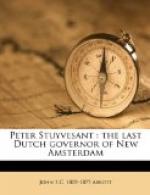“At New Amstel, on the South river, notwithstanding they offered no resistance, but demanded good treatment, which however they did not obtain, they were invaded, stript bare, plundered, and many of them sold as slaves in Virginia.”
This testimony is corroborated by a London document, which says,
“From the city and the inhabitants thereabout were taken one hundred sheep, thirty or forty horses, fifty or sixty cows and oxen, between sixty and seventy negroes, the brew-house still-house and all the material thereunto belonging. The produce of the land, such as corn, hay, etc., was also seized for the king’s use, together with the cargo that was unsold, and the bills of what had been disposed of, to the value of four thousand pounds sterling.
“The Dutch soldiers were taken prisoners, and given up to the merchant-man that was there, in payment for his services; and they were transported into Virginia to be sold. All sorts of tools for handicraft tradesmen, and all plough gear, and other things to cultivate the ground, which were in store in great quantity, were likewise seized, together with a sawmill ready to set up, and nine sea buoys with their iron chains.
“Even the inoffensive Menonists, though thoroughly non-combatant from principle, did not escape the sack and plunder to which the whole river was subjected by Carr and his co-marauders. A boat was dispatched to their settlement, which was stripped of everything, even to a very nail.”
At New Amsterdam, Colonel Nicholls paid more respect to the terms of the treaty. Citizens, residing there, were not robbed of their private property. But the gentlemen of the West India Company, in Holland, found all their property mercilessly confiscated. Colonel Nicholls seized on everything upon which he could lay his hand. He seemed anxious to eradicate every vestige of the former power. This property was sold at auction that it might thus be distributed among a large number of individual owners. The Colonel shrewdly imagined that he might thus interest all these persons in the maintenance of the new power.
History has but one voice, and that of the severest condemnation, in reference to these transactions on the part of the English government. Mr. O’Callaghan writes:
“Thus was fitly consummated an act of spoliation which, in a period of profound peace, wrested this province from the rightful owners, by violating all public justice and infringing all public law. The only additional outrage that remained was to impose on the country the name of one unknown in history, save as a bigot and a tyrant, the enemy of religious and political freedom wherever he ruled. New Netherland was accordingly called New York.”
Hon. Benjamin F. Butler, in his outline of the State of New York writes, “In the history of the royal ingrates by whom it was planned and for whose benefit it was perpetrated, there are few acts more base, none more characteristic.”




